Biochar in vineyards
by Claudio Niggli & Hans-Peter Schmidt
Biochar is one of the oldest soil conditioners in the history of agriculture. The Amazon Basin is probably the best example. Here, up to 500 years ago, a highly developed civilisation with a multi-million population was able to feed itself only through the well-conceived use of biochar. Though this is the main example, traditional farmers in most other countries were well aware of biochar’s valuable properties. We find evidence of the use of biochar in farming not only in Europe, but also in South Asia, Africa and South America.
print version with citable page numbers
In Europe, the discovery and introduction of synthetic fertilisers led to the loss of a great amount of knowledge on traditional soil conditioners. On top of this, charcoal lost its significance as fuel. Yet in many third world countries, knowledge of biochar did not completely disappear. This has meant that, for decades now, a number of large-scale, long-term experiments on the use of biochar have been carried out in Cameroon, Ghana, Bolivia, Belize, Indonesia, India and China [Lehmann, 2009]. In Europe, however, the experiment that begun in 2007 by the Delinat Institute is one of the first and largest on-farm trials. This will, however, change this year, with the 2010 biochar production capacity (350 tonnes) of Swiss Biochar’s pyrolysis plant destined for use on field trials throughout Europe.
Preparing of the trial at Mythopia
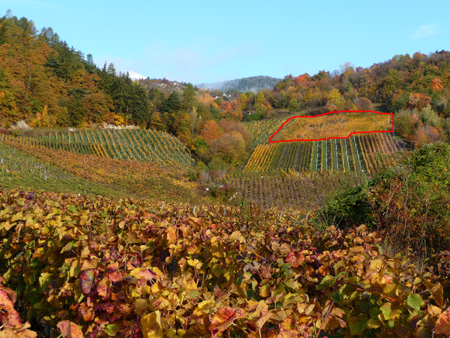
As there was no biochar available on the market in 2007, 1000 kg of charcoal dust were imported from Germany. Whereas biochar is produced from all kinds of organic materials, charcoal is obtained solely from wood. Conversely, all forms of charcoal are biochar, both being identical with respect to their carbon structure. More important than the organic material used are a) the temperature at which pyrolysis takes place and b) the amount of oxygen in the smoulder chamber. Unfortunately, neither of these parameters were available, so that we had to rely on laboratory analysis and electron microscopy to establish its properties. For this reason, alongside the outdoor field tests, the same substrates were also used for extensive plant-pot tests.
70% of biochar lumps were smaller than 2 mm, with the rest measuring up to 15mm in length. The whole 1000 kg of biochar was mixed with 8 m3 of compost [La Coulette] to form a biochar-compost (BC) mixture, which was then spread evenly over the vineyard. The BC mixture was left on the surface under the vines, but mixed into the soil between the rows. In addition to the substrate, cover crops with a high leguminous content were sown. These legumes act on the one hand as a green manure for conditioning the soil and on the other hand as a booster allowing a better analysis of nutrient balances.
The whole 3000 m2 test field was subdivided into several plots, thereby enabling the following different compositions to be used several times:
- BC mixture combined with a leguminous cover crop seed (leg/co/ch) or (LegKPk)
- Compost combined with a leguminous cover crop seed (leg/co) or (LegKp)
- Leguminous cover crop seed without biochar or compost (leg) or (Leg)
- Control plots without cover crop and compost, where plants sprouted of their own accord
Results
1. Growth
Right from the very first year, a significant increase in the vines’ nitrogen uptake was found on those plots treated with the BC mixture. As the soil was very eroded, with little humus and a high stone/dust content, the legumes were in the beginning unable to achieve any adequate symbiosis with organisms present in the soil, so that they withdrew a relatively high amount of nutrients from the soil. This were seen in the plots without biochar conditioning, where vine growth took place at a reduced level.
Symbiosis with organisms present in the soil seemed to take place faster on the plots treated with biochar, implying higher nutrient availability levels. This, in turn, led to a more even vine growth, shown not just by a higher leaf nitrogen content, but in particular by achieving ideal conditions suited for Pinot Noir (450-490). Such differences in growth patterns within the vineyard were clearly visible even for non-experts.
Wood growth during the first two years after sowing is significantly lower only in the leguminous cover soil than in the control plot. This effect can, at least, be partly compensated through the addition of biochar with compost but not with compost alone (there is no significant difference between control and the leg/co/ch plots).
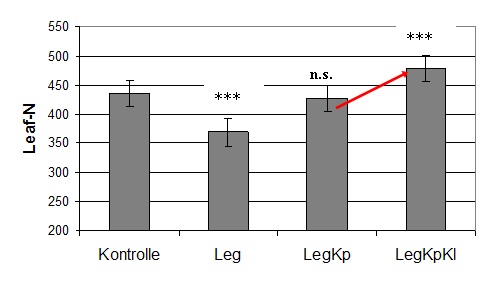
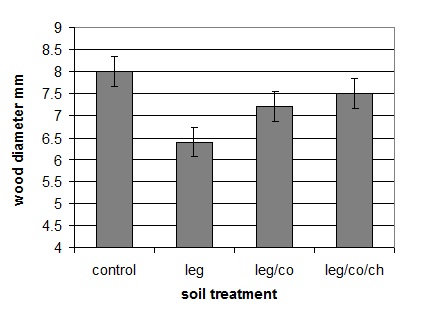
2. Significantly higher amino-acid levels in the grapes
Biochar soil treatment led to a higher (up to 300%) amino acid content in the grapes. Alongside carbohydrates, amino acids are the main source of food for yeasts in the fermentation process. A high amino-acid content is also an indication of increased plant and grape resistance to parasites, as these have much greater difficulty extracting nutrients locked in amino acids than from the simply structured ammonium.
The comparison with the control plot is remarkably demonstrated in Fig. 3. The main difference of the variations is apparent in the leguminose-treated plot and not in that with biochar treatments. Each value was determined from a mash of 300 berries. However, it is not possible to draw statistically reliable conclusions from these data.
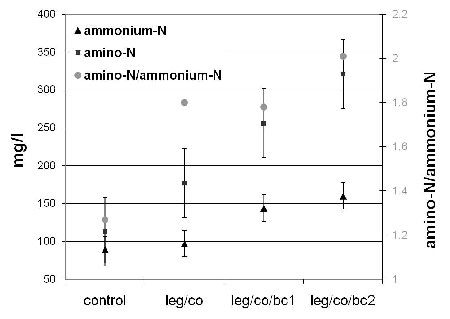
3. Improved phenolic maturity
Both tannins and anthocyanins belong to the family of soluble polyphenols. Polyphenols have antioxidant characteristics thought to have a positive effect on health. Tannins are a main source of taste in wine, also contributing to a longer shelf life. Alongside grapes’ sugar content (measured using the Oechsle scale), the so-called phenolic maturity is a major determinant of grape quality.
Grapes from biochar-treated plots had a 10% higher polyphenol content. Together with the much higher amino acid content, this was an indication of a greater aromatic quality of the grapes, which is then passed into the wine.
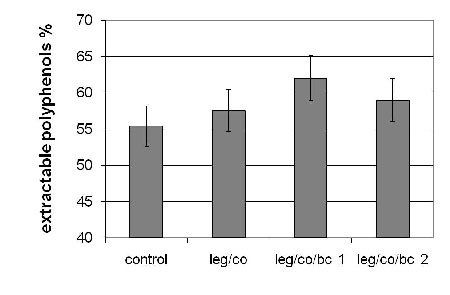
Summary
The experiment took place on a particular soil under specific conditions. The measured values are therefore to be seen only as a sample from a much wider spectrum of important indicators. The positive influence of biochar is, however, unmistakeably and impressively verified by the series of measurements conducted. The results confirm some key hypotheses in the field of biochar research and act as a clear signal to intensify research efforts into biochar and its effects on agricultural soil systems.
See also the results of the laboratory tests conducted with the same soil and the same biochar concomitantly at Zurich University. Here too, considerable insights have been gained into aspects such as water storage capability, nutrient assimilation and growth rates. (Pichler 2010)
2010 is set to be a key year for biochar research, with the area dedicated to outdoor tests increasing 500 times. In the whole of Europe, biochar-compost substrates will be worked into different kinds of agricultural soils and the resulting effects will be subjected to scientific evaluation. In addition, specialists from over 10 European universities and research institutes are now networked together, which will help close the remaining gaps in our knowledge in this field.


Bernd-J. Seitz
2010-01-24 08:44
Ich arbeite in der Natrschutzverwaltng des Landes Baden-Württemberg und kam vor ca. einem halben Jahr erstmals mit "Biokohle" in Kontakt - für uns ist das Thema deshalb so interessant, weil es evtl. eine gute Verwertungsmöglichkeit von Material aus der Landschaftspflege darstellt - Biogasanlagen haben diese Hoffnung leider nicht erfüllt. Erst vorgestern hatte ich ein Gespräch mit Frau Holweg darüber, die auch bereits Kontakt zu Delinat hatte. Ich bin gespannt, was sich daraus noch ergibt!
Herzliche Grüße
B. Seitz
Christian P. Segers
2010-01-24 09:43
Tach aber auch !
Ist es nicht erstaunlich , was wir so alles von unseren primitiven Vorvätern noch lernen können ? Vom Grossen MAGO aus Karthago in Nordafrika !! Oder den indogenen Völkern im heutigem Amazonien, unweit des Rio Xingo in Brasilien ? Oder auch von einem jap. Wissenschaftler, mit dessen Produkten wir beste (Garten-)Erfolge seit 2002 hatten !
Mit weinsinnigem Gruss >CpS<
Jochen Binikowski
2010-01-24 21:18
Das sind doch mal erfreuliche Neuigkeiten. Vieleicht sollte man eine weitere Variante testen, nämlich der Biokohle-Kompostmischung noch Holzasche und Tierdung hinzuzufügen. Das hat sich bei uns bestens bewährt. Ich bin auch schon mal auf die Langzeitwirkung gespannt. Es würde mich nicht wundern, wenn die Ergebnisse in den Folgejahren noch besser werden.
Bei aller Euphorie sollte man aber stets bedenken, dass es bei der Verwendung von Biokohle/Kompost eine Art Regel gibt: Je schlechter der ursprüngliche Boden desto besser die Wirkung. Auf guten Böden lassen sich zumeist nur geringe Verbesserungen erzielen. Aber vielleicht erleben wir bei den Wein-Experimenten auch da noch eine Überraschung.
Hans Rudolf Oberholzer
2010-01-27 13:11
Lieber Herr Schmidt
Ihr Versuch ist unter schwierigen Bedingungen korrekt angelegt und hat mich wirklich beeindruckt. Ihr Beitrag aber enthält einige Ungenauigkeiten und grundlegende Fehler bzw. Fehlinterpretationen:
- Abb1: Es gibt keinen signifikanten Unterschied zwischen Kontrolle, LegKp und LegKpKl . Die Unterschiede sind deshalb wissenschaftlich als zufällig oder höchstens als Trend zu interpretieren.
- Abb. 2: Die Wachstumsunterschiede zeigen offensichtlich auch keine signifikanten Unterschiede, tendenziell scheint das Wachstum eher bei der Kontrolle am besten zu sein. Der Unterschied zwischen leg/co/ch und dem für die Wirkung der Biokohle direkt zu vergleichenden Verfahren leg/co ist auf jeden Fall am geringsten.
- Abb. 3: Falls die Ergebnisse aus demselben Versuch stammen, sind die Verfahren falsch beschriftet. Falls die Verfahren dieselben sind wie in den ersten beiden Abbildungen, ist der Unterschied zwischen dem Verfahren mit Biokohle und demjenigen ohne Biokohle (mit Leguminosen und Kompost) sehr gering und sicher nicht signifikant.
- Abb. 4: Wo sind die Ergebnisse des 3. Verfahrens (LegKp). Keine signifikanten Unterschiede.
Fazit: Es gibt kein einziges Ergebnis, das einen signifikanten Einfluss von Biokohle zeigt.
[Im Anschluss an diesen Kommentar wurde der Artikel nochmals ergänzt und die Beschriftung der Abbildungen erweitert. Mit bestem Dank, die Redaktion]
hps
2010-01-27 15:09
Lieber Herr Oberholzer,
vielen Dank für Ihre genaue Lektüre und Auswertung. Insgesamt würde ich Ihnen insofern zustimmen, dass diese ersten Versuchsergebnisse einen Trend erkennen lassen, aber noch keinen wissenschaftlichen Beweis für die Wirksamkeit liefern. Offenbar habe ich dies im Artikel nicht deutlich genug gemacht.
Gern würde ich noch zu den einzelnen Punkten Stellung beziehen:
-Abb1: Für die Ermittlung der jeweiligen Blattstickstoffwerte wurde für jede Variante 150 Messwerte zugrunde gelegt, so dass der statistische Mittelwert durchaus verlässlich ist. Der Unterschied zwischen LgKp und LgKpK beträgt 10%, was nach rein statistischen Verfahren tatsächlich noch im Bereich des Zufalls liegen könnte. Da es sich aber um ziemlich genau ermittelbare Blattstickstoffwerte handelt, bei denen bereits geringe Schwankungen großen Einfluss auf das Wachstumsverhalten haben, ist die Differenz von 10% durchaus signifikant. Der Unterschied zwischen 430 und 480 N-Einheiten äußert sich bei Pinot Noir durch deutliche Ernte und Blattwachstumsunterschiede.
-Abb2: Hier stimme ich Ihnen zu. Die Unterschiede zwischen LgKp und LgKpK sind nicht signifikant. Die Kontrolle ist hier am wuchskräftigsten einzuschätzen. Der eigentliche Vergleich findet innerhalb der Lg-Varianten statt.
-Abb3: Die Ergebnisse stammen von denselben Versuchsflächen. Hier wurden die Werte jeweils aus der Maische von 300 Trauben ermittelt. Es wurden vier Flächen getestet: 1 x Kontrollfläche, 1 x Leguminose ohne Kompost und ohne Kohle, 2 x Leguminose mit Kompost und Kohle (an zwei verschiedenen Lagen). Da es sich hier nur um vier Varianten handelt ist eine gesicherte statistische Auswertung nicht möglich. Sichtbar freilich wird eine zu überprüfende Tendenz. Bei Unterschieden von 50 - 100% scheint diese signifikant.
-Abb4: Es handelt sich um die gleichen Messreihen wie für Abb3, nur das die beiden LgkoK-Varianten zusammengezogen wurden. Ein signifikanter Unterschied besteht hier nicht!
Diese ersten Ergebnisse des Versuches haben noch nichts bewiesen. Was wir erkennen konnten sind gewisse m.E. durchaus signifikante Tendenzen, durch die wir Indizien für die Fortsetzung und Ausweitung der Versuche erhalten. Durch diese ersten Messwerte und Beobachtungen wissen wir besser, worauf wir im kommenden Jahr mit besseren und umfassenderen Mitteln unsere wissenschaftliche Aufmerksamkeit lenken, um genauere und besser verwertbare Resultate zu erhalten.
Mit freundlichem Dank, Hans-Peter Schmidt
Horst Wagner
2010-01-27 23:55
Sehr geehrter Herr Schmidt,
nach meinen Berechnungen hat Ihre HK-Kompost-Mischung einen HK-Anteil von ca. 28% (Berechnung nachfolgend). Ist dieser m.E. extrem hohe HK-Anteil der Bodenqualität geschuldet, Sie beschreiben zum Teil extrem verarmte Böden, oder verfolgen Sie vordergründig eine möglichst hohe C-Sequestrierung?
Bei meinen bescheidenen Versuchen konnte ich schon bei einem HK-Anteil im Kompost von unter einem Prozent Erfolge erkennen. Im Frühjahr sind neue "Terra-Preta"-Versuche mit 5%, max. 10% HK-Anteil geplant.
Ich habe die "deutsche" Holzkohle abgewogen, wobei der HK-Staub (bis 2mm) ca. 300 g/l wiegt und der HK-Kies (0-15mm) ca 420g.
Daraus ergibt sich für 700kg HK-Staub ein Volumen von ca. 2333l und für 300 kg HK-Kies 715l. Dazu kommen 8000l Kompost (8cbm) ergibt 11048l Mischung auf 1/4 der Versuchsfläche von 3000qm, also 750 qm. Das sind knapp 15l je qm. 2333l plus 715l ergibt 3048l, d.s. ca. 28% des Gesamtvolumens von 11048l.
Wenn ich die Versuchsbeschreibung richtig verstanden habe.
Mit schwarzen Grüßen
Horst Wagner
hps
2010-01-28 20:09
Sehr geehrter Herr Wagner,
als wir vor 2 Jahren den Versuch anlegten, hatten wir als einziges Mengenindiz jene 10 - 120 t pyrogenen Kohlenstoffs pro Hektar. Unstrittig war für uns, dass wir die Kohle biologisch aktivieren müssen, wofür uns Kompost am geeignetsten schien. Bei der Kompostmenge haben wir uns dann an die Nährstoffwerte der Böden gehalten. Auf diese Weise ist der hohe HK-Gehalt zustande gekommen.
Zur Herstellung von Bodensubstrates würde ich heute HK-Anteile von 1% - 10% für geeignet halten. Gespannt warte ich auf die ersten Resultate darüber, zu welchem Zeitpunkt der Rotte wieviel Kohle den Kompostierprozess wie beeinflusst. Darüber werden wir im kommenden Jahr endlich mehr wissen.
Was die Bodenregeneration betrifft, so halte ich HK-Mengen von 10 - 20 t / ha (vermischt mit Kompost/Gärgut) und zwar als einmalige Gabe noch immer für angebracht. Die Kohle gibt die Struktur für die "Kohle-Humus-Lehm-Mikroben-Komplexe" und solange sie biologisch aufgeladen ist, sehe ich keinen Grund, dies auf mehrere Gaben zu verteilen und dabei jedes Mal den Boden wieder zu öffnen und das Boden-Netzwerk zu stören. Aber vielleicht werden wir auch darüber in den nächsten zwei bis fünf Jahren eines Besseren belehrt.
Mit bestem Dank und Grüssen, Ihr Hans-Peter Schmidt
Jörg Stüdeli
2010-01-30 17:24
Besten Dank für Ihre interessanten Artikel über Bio-Holzkohle.
Haben Sie gewusst, dass Al Gore in seinem aktuellen Buch „Wir haben die Wahl – Ein Plan zur Lösung der Klimakrise“ recht ausführlich über Bio-Holzkohle schreibt (S. 132, 216ff.). Er weist auf deren riesiges Potenzial hin, aber auch auf Umweltaktivisten, welche die Besorgnis haben, das sich bei einer mangelhaften Umsetzung die Fehler des Palmölbooms wiederholen könnten.
Al Gore zitiert Flannery, welcher in einem offenen Brief schrieb: „Biokohle könnte die wichtigste Einzelmassnahme zur Sicherung der ökologischen Zukunft der Menschheit sein. Dieser Ansatz hat den Vorteil, dass er sowohl die Lebensmittelversorgung sichert als auch die Treibstoffkrise sowie das Klimaproblem angeht – und das ganz pragmatisch. Holzkohlegewinnung ist uralt – doch für uns etwas völlig Neues.“
Guydegif(F - 91)
2013-09-16 15:32
Bonjour,
Je suis très intéressé par le BioChar et ses apports en agriculture.
L'article de Claudio et Hans-Peter est très intéressant de par ses 1ers résultats et constats, et prometteur:
''Pour la recherche dans le domaine du charbon bio, l’année 2010 est une étape décisive. Les surfaces pour les essais sur le terrain vont être multipliées par 500. Dans toute l’Europe, des substrats composés de charbon bio et de compost seront incorporés dans les surfaces utiles agricoles les plus diverses. Leur répercussions seront interprétées scientifiquement. En outre, des spécialistes de plus de 10 universités et instituts ont formé un réseau dans le but de contribuer à combler les dernières grandes lacunes dans ce domaine.''
--> Nous sommes en sept 2013 ! Qu'en est-il de 2010, année décisive pour le BioChar? En CH, mais aussi dans toute l'Europe?
Quels sont les résultats sur une application plus large du BioChar?
J'aimerais bien savoir !
Merci de nous dire
A+ Cordialement
Guy Weider